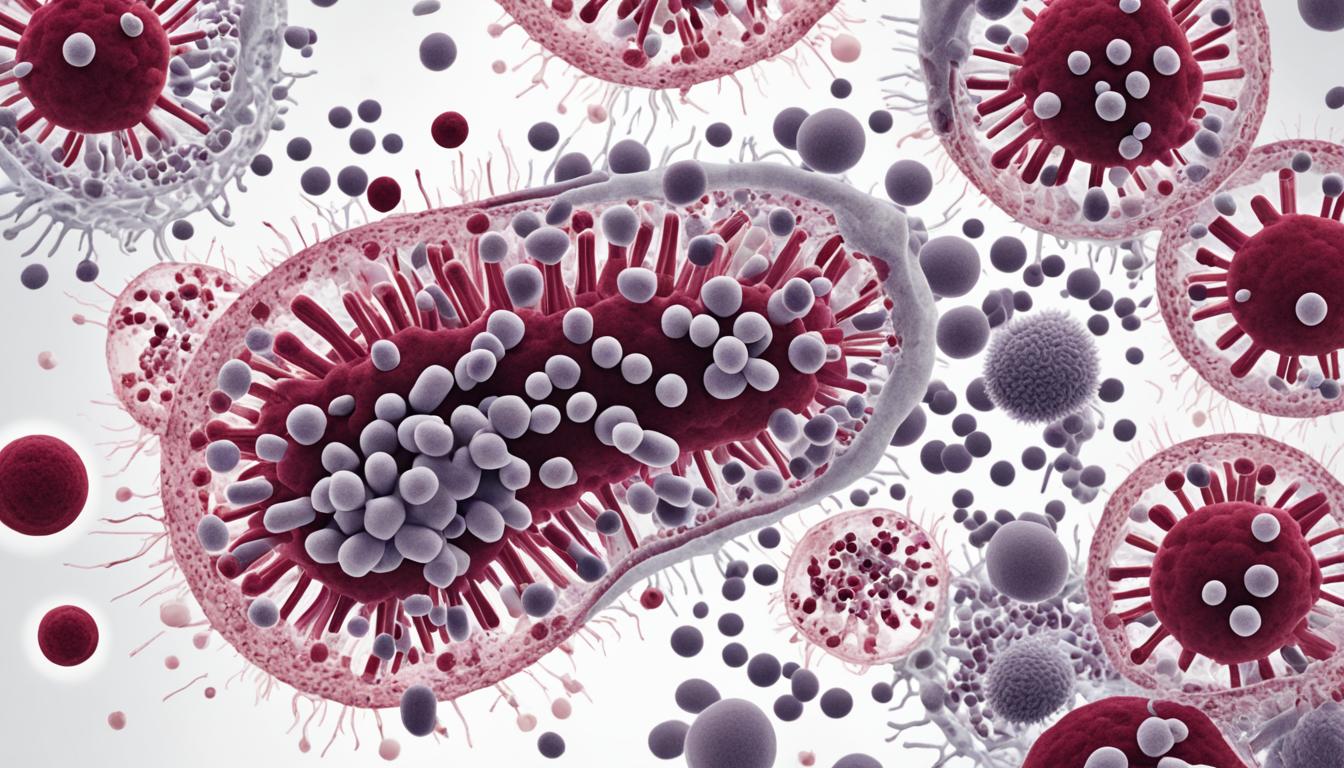Brucellosis is caused by Brucella bacteria. It’s a disease passed between animals and humans. Usually, it affects livestock. Symptoms include fever, sweats, tiredness, and joint pains. It spreads by touching infected animals or eating their products.
Diagnosing brucellosis is tough, but we use serological tests and PCR methods. We treat it with antibiotics like streptomycin, doxycycline, and ciprofloxacin. To stop it, we vaccinate livestock, treat the milk, and keep clean when working with animals. Scientists are looking into using stem cells to treat brucellosis. But, they still need to do more research.
Key Takeaways:
- Brucellosis is a zoonotic disease caused by Brucella bacteria.
- Symptoms of brucellosis include fever, sweating, fatigue, and joint pain.
- The disease can be transmitted to humans through direct contact with infected animals or consumption of contaminated animal products.
- Diagnosis is challenging but can be done using serological tests and PCR-based techniques.
- Treatment involves a combination of antibiotics.
- Prevention includes vaccination of livestock, pasteurizing milk, and maintaining good hygiene practices in animal handling.
Causes and Transmission of Brucellosis
Brucellosis comes from the Brucella bacteria. Humans can get it from animals. It’s important to know how it spreads to stop its spread.
Direct Contact with Infected Animals
Touching infected animals is a common way to catch Brucellosis. This happens when handling things like placenta, fetal fluids, or raw milk. People who work closely with these animals can be more at risk, like farmers and veterinarians.
Consumption of Contaminated Animal Products
Eating food from infected animals is another way to get Brucellosis. This includes drinking raw milk or eating raw meats and cheeses. Make sure to cook food well and practice good hygiene to lower your risk.
Vertical Transmission from Mother to Fetus
Vertical transmission happens from mother to baby. This can also affect baby animals. It shows the need to keep livestock healthy with vaccines and good management. This prevents the bacteria from getting into animal products we use.
To avoid brucellosis, here are some important steps to take:
- Use good hygiene with animals. Wear gloves and wash hands well after touching them.
- Get animals vaccinated to prevent Brucella bacteria.
- Always pasteurize milk to make it safe.
| Mode of Transmission | Description |
|---|---|
| Direct Contact | Transmitted through handling placenta, fetal fluids, or raw milk from infected animals. |
| Consumption of Contaminated Animal Products | Infected meat, milk, or cheese can introduce the bacteria into the human body through consumption. |
| Vertical Transmission | Transmission from infected mother to fetus, increasing the risk of infection in newborn animals. |
Diagnosis, Treatment, and Prevention of Brucellosis
Diagnosing brucellosis might be hard at first. This is because its symptoms are vague, and the bacteria, Brucella, can hide in cells. However, doctors often use serological tests for a first check. Tests like the Rose Bengal tube test and ELISA look for antibodies against the bacteria. For a clearer diagnosis, PCR-based methods are quite effective. These tests look for the DNA of the bacteria and are more precise.
The main treatment for brucellosis is antibiotics. A mix of drugs like streptomycin, doxycycline, and ciprofloxacin is usually used. How long and which specific antibiotic to take depends on how bad the infection is and the patient’s health. It’s crucial to finish all the antibiotics. This ensures the bacteria is completely gone and won’t come back.
Preventing brucellosis mainly starts with livestock vaccination. This lowers the disease in animals. Making sure milk is pasteurized helps remove Brucella from dairy. Being clean and careful when around animals is key. This includes properly getting rid of afterbirth and fluids. These steps help stop the bacteria from reaching people. Following these hints lowers the chance of getting brucellosis for animals and humans.

